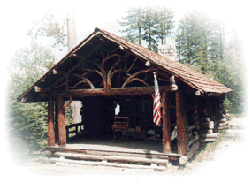
Tallac: Yesteryear & Today

The American public is a notoriously fickle lot. While one generation embraces progress, the next generation longs for what has gone before. At present, the latter sentiment holds sway, and in the Lake Tahoe Basin, its influence can be seen in conscious efforts to preserve what remains of "Old Tahoe," both by individuals and public entities. During the last three decades, this emphasis on yesterday has been reflected in the policy of the US Forest Service, resulting in an escalating pattern of federal acquisition and restoration of historic sites and structures.
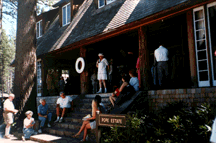 An
example of this policy at work is the Tallac Site, a cluster of three private
estates acquired by the Forest Service between 1965 and 1971. This property,
comprising 74 acres and including over a quarter of a mile of lake frontage,
is situated between Emerald Bay and Camp Richardson. Two of the site's three
estates - the Baldwin (also known as the McGonagle) and Heller properties date
back to the 1920s. The third, known as the Tevis-Pope estate, is nearly 30 years
older. Though the architecture of each is unique from its neighbors, all represent
varying aspects of the much-touted "Old Tahoe" style.
An
example of this policy at work is the Tallac Site, a cluster of three private
estates acquired by the Forest Service between 1965 and 1971. This property,
comprising 74 acres and including over a quarter of a mile of lake frontage,
is situated between Emerald Bay and Camp Richardson. Two of the site's three
estates - the Baldwin (also known as the McGonagle) and Heller properties date
back to the 1920s. The third, known as the Tevis-Pope estate, is nearly 30 years
older. Though the architecture of each is unique from its neighbors, all represent
varying aspects of the much-touted "Old Tahoe" style.
Oldest of the Tallac Site's residences is the main building of the Tevis-Pope estate, completed in 1894. Massive log columns highlight the building's somewhat rustic external appearance, yet inside, the decor represents a relatively formal period of Tahoe life. Though his name is rarely mentioned in connection with the property, the home was originally constructed for George P. Tallant, guiding light of San Francisco's Crocker Bank and an avid fisherman for whom the Tallant Lakes (west of Meeks Bay) were named.
In 1899, Tallant sold the property to Lloyd Tevis, director and later president of Wells Fargo Bank. But Tevis died before the close of escrow, and the estate became the property of his son, William S. Tevis. Under the direction of the younger Tevis, development of the residence and grounds proceeded in grand style, supplementing the already ample blessings of nature. In 1902, a portion of Taylor Creek was diverted to supply a private trout pond, into which cascaded a picturesque waterfall - highlight of an arboretum featuring the greatest collection of botanical specimens at the Lake. Amid this wealth of exotic flora sat a quaint gazebo, or "folly." The native materials used in its construction and furnishings lent a whimsical air to the woodland scene.
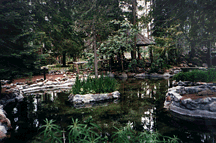 In
spite of his efforts to retain ownership, financial setbacks forced Tevis to
sell his beloved estate in 1923. The new owner, George A. Pope, Sr., named his
38 acre playground "Vatican Lodge" - an obvious pun on his surname. The Pope
family fortunes had included in volvement in the shipping industry, and marine
pursuits were also among their favored recreational activities. The SHEIK, a
60 foot Elco cruiser which had formerly seen service as a West Coast rum runner,
was the Pope's private excursion and party boat, stored in a large boathouse
on the property when not in use. And their Sea Lyon runabout was a frequent
sight in Tahoe waters prior to World War l l.
In
spite of his efforts to retain ownership, financial setbacks forced Tevis to
sell his beloved estate in 1923. The new owner, George A. Pope, Sr., named his
38 acre playground "Vatican Lodge" - an obvious pun on his surname. The Pope
family fortunes had included in volvement in the shipping industry, and marine
pursuits were also among their favored recreational activities. The SHEIK, a
60 foot Elco cruiser which had formerly seen service as a West Coast rum runner,
was the Pope's private excursion and party boat, stored in a large boathouse
on the property when not in use. And their Sea Lyon runabout was a frequent
sight in Tahoe waters prior to World War l l.
The senior Pope's love of Tahoe was a legacy which succeeded to the next generation, and his children continued the tradition of summers at the Lake into the 1960s. Yet in 1965, the family completed negotiations to transfer title of their "Vatican Lodge" to the Forest Service, their thought being to preserve the estate for the enjoyment of future generations of visitors.
To the west of the Tevis-Pope property lies the former site of E.J. "Lucky" Baldwin's Tallac Hotel. Baldwin passed away in 1909, and the complicated transfers of title, by which a portion of the hotel property came into the possession of Dextra Baldwin Winter (Baldwin's grand daughter), was concluded about 1915. In that year, a structure from the old hotel grounds was relocated to Dextra's recently-acquired parcel to serve as a temporary dwelling during the construction of her permanent residence.
The U-shaped main house on the Baldwin property, completed by 1922, featured a wishing well in its interior courtyard, and a massive stone fireplace dominated the living room,. The finest materials and workmanship were used in the construction of this summer home, from its Western Incense Cedar log walls to its wrought iron fixtures.
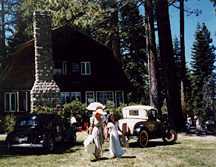 It
should be noted that though many references to this estate use the name McGonagle,
such use is actually a misnomer, since the residence was actually constructed
during the heiress's (first) marriage to Ardine Winter (one of the founders
of Richfield Oil). Dextra married three times, and it is entirely possible that
James R. McGonagle, her third husband,never set foot in the house which bears
his name.
It
should be noted that though many references to this estate use the name McGonagle,
such use is actually a misnomer, since the residence was actually constructed
during the heiress's (first) marriage to Ardine Winter (one of the founders
of Richfield Oil). Dextra married three times, and it is entirely possible that
James R. McGonagle, her third husband,never set foot in the house which bears
his name.
In contrast to the lively round of activities which characterized life at the Tevis-Pope estate, Dextra Baldwin's brand of social intercourse was of a more subdued nature, though the entertainment of close personal friends was an integral part of the estate's seasonal use.
"Valhalla," the Heller estate, was conceived in 1922 by San Francisco investment broker Walter S. Heller. The name "Valhalla," taken from the great hall of the Viking after life, provided an apt description of the Heller residence, which featured a vaulted central living area sur rounded by a horseshoe balcony, all of massive timber and stone and sufficient in size to accommodate several dozen people.
Walter Heller and his wife, Claire, divorced in 1936, but their mutual love of Tahoe was undying, and they used the state on alternate weekends for 20 years thereafter. In 1955, Claire Heller Strauss sold the estate to Wilber E. Kuhl, and five years later, Kuhl in turn sold to Raymond H. Goodrich. In 1965, Goodrich sold the property to the South Tahoe Valhalla Corporation, a private yacht club with plans to develop the choice lakefront property as a members-only marine paradise. However, this enterprise met with failure when few memberships sold, and in 1971, the property was acquired by the federal government.
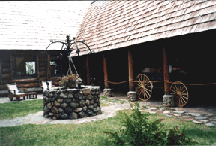
Story by Carol Van Etten
Photos by Jill Beede

